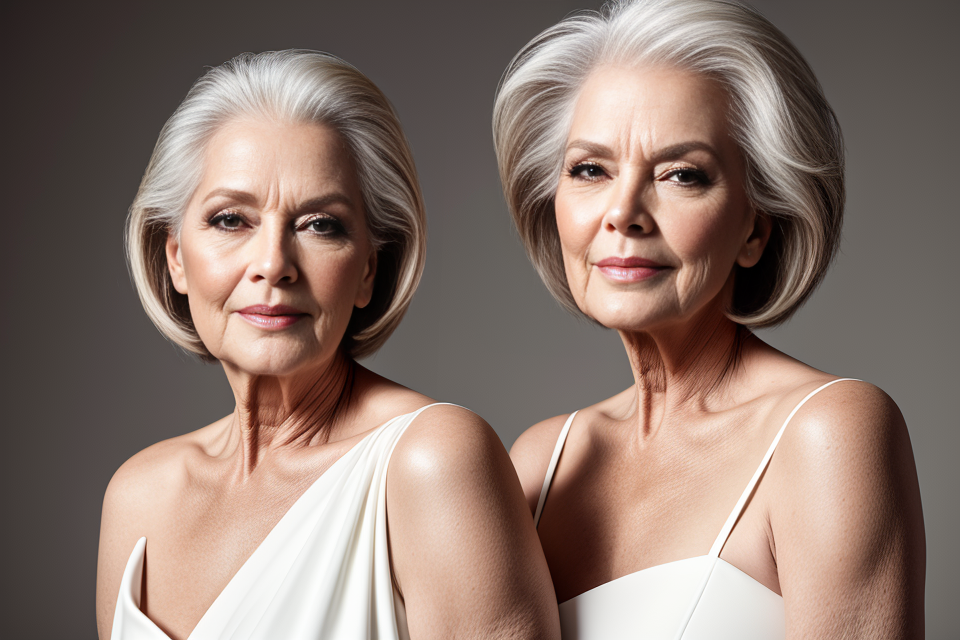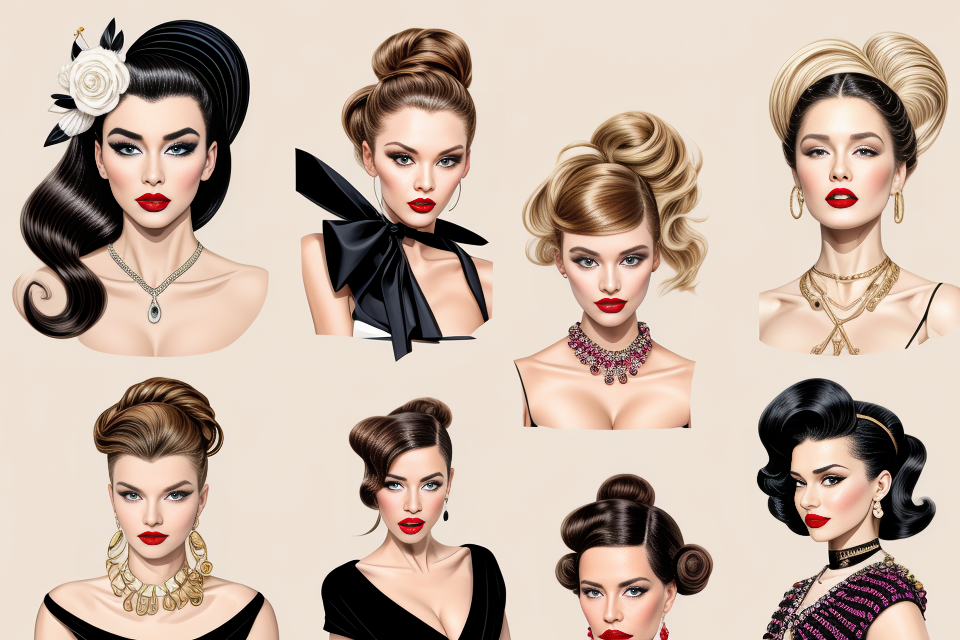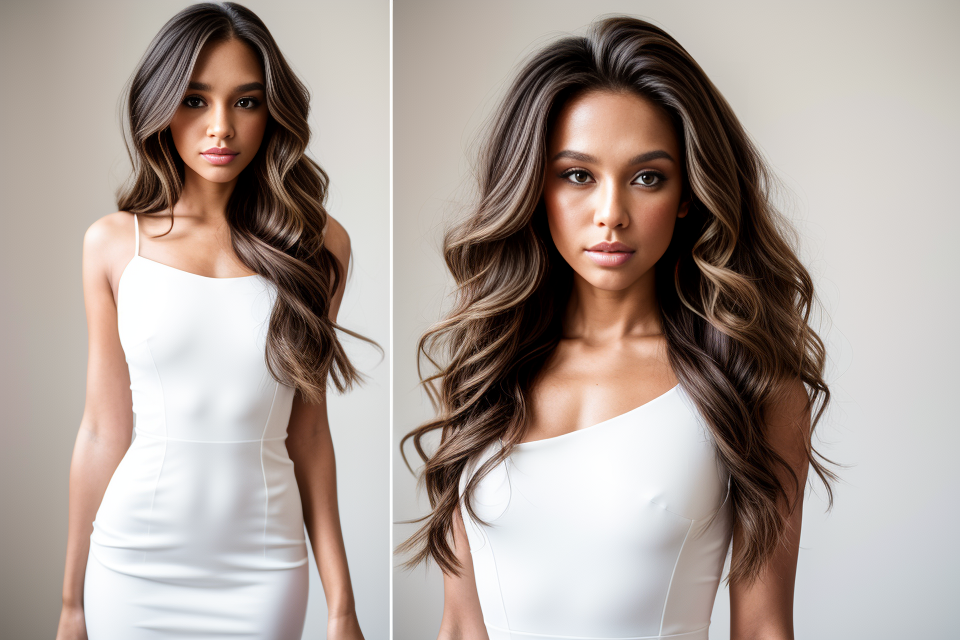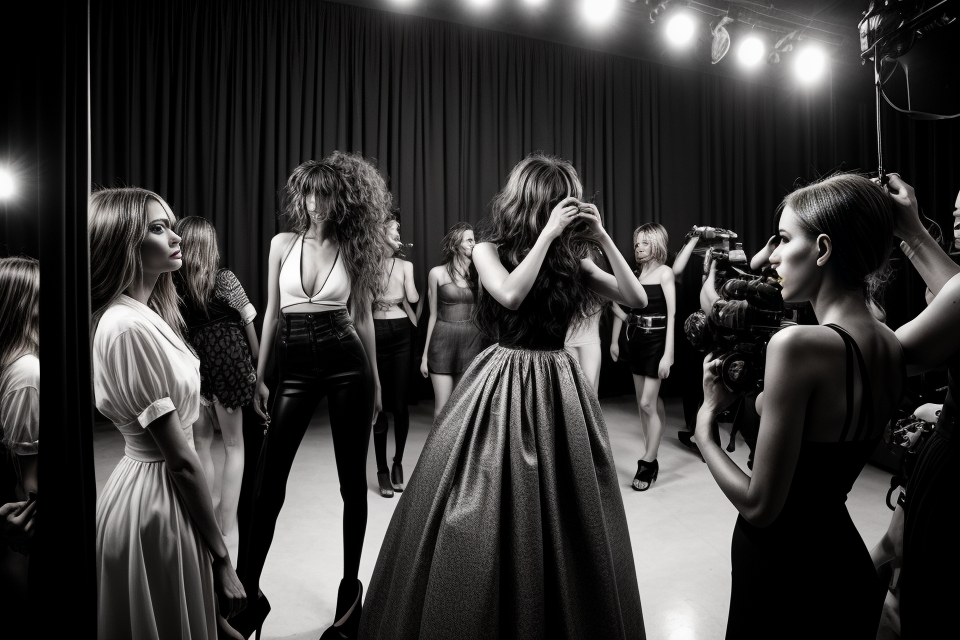
Age is just a number, or so they say. But when it comes to the world of fashion modeling, is there an expiration date for a successful career? The question of whether 25 is too old to be a fashion model has been a topic of debate for years. While some argue that age brings experience and maturity, others believe that the fashion industry favors youth and beauty above all else. In this article, we will explore both sides of the argument and determine whether 25 is indeed too old to be a fashion model.
The age limit for fashion models is a topic of much debate in the industry. While some argue that there should be no restrictions on age, others believe that a cut-off is necessary to maintain a certain aesthetic. At present, the majority of high-profile fashion modeling jobs go to women under the age of 25. However, this does not mean that older models are not successful or sought after. In fact, many older models have found success in the industry and continue to work well into their 30s and beyond. Ultimately, the age limit for fashion models should not be viewed as a strict rule, but rather as a guideline that can be interpreted and adapted to suit the needs of individual clients and brands.
The Perceived Ideal Age for Fashion Models
Factors Influencing the Perceived Ideal Age
Industry trends and preferences
The fashion industry is known for its ever-changing trends and preferences, and this is reflected in the ideal age for fashion models. Historically, the fashion industry has favored younger models, with many designers and brands opting for models in their late teens and early twenties. This preference for younger models is often driven by the desire to project an image of youth and vitality, and to appeal to a younger target demographic.
However, in recent years, there has been a shift towards older models, with many designers and brands recognizing the value of experienced, mature models who can bring a sense of sophistication and elegance to their campaigns. This shift towards older models has been driven in part by changing social attitudes towards aging and the growing recognition of the importance of diversity and inclusivity in the fashion industry.
Physical attributes and characteristics
The physical attributes and characteristics of fashion models can also influence the perceived ideal age for models in the industry. For example, models with more youthful features, such as smooth skin and a slender figure, may be favored for certain types of campaigns or brands. Similarly, models with more mature features, such as wrinkles and a curvaceous figure, may be favored for other types of campaigns or brands.
In general, the ideal age for fashion models tends to be correlated with the physical attributes and characteristics that are currently in vogue in the industry. For example, during the 1990s, models with a more athletic, tomboyish look were favored, while in the 2000s, models with a more glamorous, high-fashion look were favored.
Marketing strategies and target demographics
The marketing strategies and target demographics of fashion brands can also influence the perceived ideal age for fashion models. For example, brands that target a younger demographic may favor younger models, while brands that target an older demographic may favor older models. Similarly, brands that aim to project a sense of sophistication and elegance may favor models with more mature features and a more experienced demeanor.
In general, the ideal age for fashion models is influenced by a range of factors, including industry trends and preferences, physical attributes and characteristics, and marketing strategies and target demographics. As the fashion industry continues to evolve and diversify, it will be interesting to see how these factors influence the perceived ideal age for fashion models in the years to come.
Evolution of the Ideal Age in the Fashion Industry
- Historical context and changes in fashion trends
- The golden age of fashion modeling (1940s-1960s)
- Iconic models like Marilyn Monroe and Twiggy
- Emphasis on glamour and femininity
- The supermodel era (1970s-1990s)
- Models like Naomi Campbell, Cindy Crawford, and Linda Evangelista
- International fashion shows and media exposure
- The contemporary age (2000s-present)
- Diversification of models and body types
- Sustainability and social responsibility in fashion
- The golden age of fashion modeling (1940s-1960s)
- Shifts in societal attitudes and beauty standards
- Movements like body positivity and inclusivity
- Impact of social media and digital platforms
- Amplification of diverse voices and representations
- Pressure to maintain youthful appearance
- Influence of social media and digital platforms
- Rise of influencers and micro-celebrities
- Platforms like Instagram and TikTok
- Exposure to global audiences
- Opportunities for aspiring models
- Challenges and pressures of online competition
- Constant self-promotion and branding
- Maintaining a youthful image for marketability
Breaking Down the Myth: 25 Is Not Too Old to Be a Fashion Model
Success Stories of Mature Fashion Models
While the fashion industry is often perceived as being exclusive to young models, there are numerous examples of mature models who have achieved great success and contributed significantly to the industry. By examining the high-profile cases of older models who have made a mark in the fashion world, we can debunk the myth that 25 is too old to be a fashion model.
High-profile models who started their careers later in life
- Karlie Kloss: American model Karlie Kloss began her career at the age of 16 and quickly rose to fame. However, she didn’t reach the peak of her career until she was in her mid-20s. She has since become one of the most sought-after models in the industry, walking the runways for top designers and gracing the covers of numerous fashion magazines.
- Coco Rocha: Canadian model Coco Rocha started modeling at the age of 16 but didn’t become an international sensation until she was in her late 20s. Known for her stunning looks and impressive runway presence, Rocha has been a force to be reckoned with in the fashion industry for over a decade.
- Lauren Hunt: Australian model Lauren Hunt began her modeling career at the age of 25 and quickly made a name for herself in the industry. She has since appeared on the covers of numerous fashion magazines and has walked the runways for top designers around the world.
Achievements and contributions of mature models in the industry
- Iman: Supermodel Iman began her career at the age of 25 and went on to become one of the most successful models of her generation. In addition to her modeling career, she has also made significant contributions to the industry as a businesswoman and philanthropist.
- Naomi Campbell: British model Naomi Campbell began her career at the age of 15 but didn’t achieve international fame until she was in her late 20s. Known for her fierce runway presence and stunning looks, Campbell has been a dominant force in the fashion industry for over three decades.
- Gisele Bündchen: Brazilian model Gisele Bündchen started her career at the age of 16 but didn’t become a household name until she was in her mid-20s. She has since gone on to become one of the most successful models in history, with a career spanning over two decades and numerous accolades to her name.
The impact of diverse representation in fashion
The success of mature models in the fashion industry has also contributed to a more diverse and inclusive representation of beauty standards. By featuring models of all ages, shapes, and sizes, the fashion industry has shown that beauty is not limited to a specific age or physical appearance. This shift towards diversity and inclusivity has not only benefited mature models but has also created opportunities for models of all ages and backgrounds to make their mark in the industry.
Factors Contributing to a Successful Modeling Career Beyond 25
- Physical and mental preparedness
- Regular exercise and proper nutrition to maintain a healthy weight and fitness level
- Maintaining a positive attitude and resilience in the face of challenges
- Taking care of mental health through stress management techniques and therapy if needed
- Staying relevant and adapting to industry changes
- Keeping up with current fashion trends and styling techniques
- Expanding skill set to include photography, social media management, and event planning
- Networking with other professionals in the industry to stay informed about new opportunities and developments
- Building a strong personal brand and network
- Developing a unique personal style and creating a cohesive portfolio
- Establishing a strong online presence through social media and personal website
- Networking with clients, photographers, and other industry professionals to build a supportive community and increase visibility.
The Importance of Experience and Maturity in Fashion Modeling
How Life Experience Enhances Modeling Performance
While physical appearance plays a significant role in fashion modeling, it is not the only factor that determines a model’s success. Life experience, including personal and professional experiences, can significantly enhance a model’s performance, providing them with a unique perspective and skill set that can set them apart from their peers.
One way in which life experience enhances modeling performance is by increasing confidence and self-assurance. As individuals age, they often develop a deeper understanding of themselves and their abilities, leading to increased confidence in their own skin. This confidence can translate to a more commanding presence on the runway or in front of the camera, making them more convincing and compelling to watch.
Additionally, life experience can provide models with a better understanding of body language and nonverbal communication. This is particularly important in fashion modeling, where models are often required to convey a message or tell a story through their poses and expressions. By drawing on their personal experiences, models can bring a sense of authenticity and depth to their performances, making them more captivating and engaging to watch.
Finally, life experience can also enhance a model’s ability to convey emotions and tell a story through their performances. As individuals age, they develop a more nuanced understanding of the human experience, including the full range of emotions that can be expressed through body language and expression. This understanding can enable models to bring a deeper level of emotion and authenticity to their performances, making them more believable and impactful.
Overall, the importance of experience and maturity in fashion modeling cannot be overstated. While physical appearance is certainly important, it is life experience that can truly set a model apart, providing them with the skills and perspective needed to deliver captivating and impactful performances.
Mentorship and Giving Back to the Fashion Community
As models age, they can transition from being passive subjects on a runway or photo shoot to becoming active contributors to the fashion industry. With their years of experience, models can offer invaluable mentorship to younger models and aspiring industry professionals. This mentorship is crucial in fostering the growth and development of new talent, while also giving back to the fashion community.
One way models can give back to the fashion community is through philanthropic initiatives. Many models are involved in charitable causes and use their platforms to raise awareness and funds for various causes. For example, models may participate in fundraising events, charity fashion shows, or even create their own foundations to support causes they are passionate about.
Another way models can give back to the fashion community is by volunteering their time and expertise. This can involve mentoring younger models, providing advice and guidance to aspiring industry professionals, and sharing their experiences and knowledge. This type of mentorship is crucial in helping new talent navigate the industry and learn from those who have already achieved success.
Additionally, experienced models can also participate in community involvement initiatives. This can include hosting workshops, participating in panel discussions, or speaking at industry events. By sharing their experiences and insights, models can help shape the future of the fashion industry and inspire the next generation of talent.
Overall, the value of experience and knowledge sharing is immeasurable in the fashion industry. As models age, they have the opportunity to give back to the community that has helped them achieve success. Through mentorship, philanthropy, and community involvement, models can leave a lasting impact on the fashion industry and ensure its continued growth and development.
Embracing Diversity and Inclusivity in Fashion Modeling
The Benefits of a Wide Range of Age Representation
Showcasing real-life beauty and relatability
One of the primary benefits of having a wide range of age representation in fashion modeling is the ability to showcase real-life beauty and relatability. Traditionally, the fashion industry has been criticized for promoting unrealistic beauty standards that are often unattainable for the average person. By featuring models of different ages, the industry can better reflect the diversity of its audience and promote a more realistic and inclusive vision of beauty.
Broadening the appeal and marketability of fashion brands
Another benefit of a wide range of age representation in fashion modeling is that it can broaden the appeal and marketability of fashion brands. Brands that cater to a diverse range of customers need to be mindful of the age range of their target market. By featuring models of different ages, brands can appeal to a wider range of customers and increase their marketability. This is particularly important in an increasingly competitive market where brands are constantly looking for ways to stand out and differentiate themselves.
Encouraging self-acceptance and body positivity
Finally, a wide range of age representation in fashion modeling can encourage self-acceptance and body positivity. Many people struggle with body image issues and low self-esteem, and seeing models who look like them can be a powerful tool in promoting self-acceptance and body positivity. By featuring models of different ages, the fashion industry can help to challenge unrealistic beauty standards and promote a more positive and inclusive body image message.
Challenging Traditional Beauty Standards and Stereotypes
Traditional beauty standards and stereotypes have long plagued the fashion industry, often limiting opportunities for individuals who do not fit the conventional mold. However, with the growing push for diversity and inclusivity, these outdated norms are gradually being challenged and revised. By promoting a more inclusive and diverse fashion industry, individuals of all ages and backgrounds are empowered to pursue their dreams, regardless of their physical appearance.
Promoting a more inclusive and diverse fashion industry
The fashion industry has a significant impact on societal perceptions of beauty and fashion. Therefore, it is crucial to promote a more inclusive and diverse environment that celebrates individuality and breaks down barriers. This includes showcasing models of various ages, body types, races, and abilities in fashion campaigns and runway shows. By featuring models that reflect the diverse world we live in, fashion brands can demonstrate their commitment to inclusivity and showcase their products to a broader audience.
Empowering individuals of all ages and backgrounds to pursue their dreams
One of the most significant benefits of challenging traditional beauty standards and stereotypes is the empowerment of individuals to pursue their dreams, regardless of their age or background. When fashion brands embrace diversity and inclusivity, they send a powerful message that beauty is not limited to a specific age or physical appearance. This empowers individuals who may have felt excluded or underrepresented in the fashion industry to pursue their passion for modeling, regardless of their age or background.
Raising awareness of the impact of beauty standards on mental health and self-esteem
Another essential aspect of challenging traditional beauty standards and stereotypes is raising awareness of their impact on mental health and self-esteem. The fashion industry has long perpetuated unrealistic beauty standards that can lead to low self-esteem, body dissatisfaction, and mental health issues. By challenging these norms and promoting a more inclusive and diverse environment, fashion brands can help raise awareness of the importance of self-acceptance and body positivity. This can have a positive impact on individuals’ mental health and well-being, as well as foster a more positive self-image.
Navigating the Modeling World Beyond 25: Tips and Resources
Building a Strong Support System
- Working with experienced agents and managers
- When looking for representation beyond the age of 25, it’s crucial to find agents and managers who have experience working with older models. These professionals understand the unique challenges that come with navigating the industry at an older age and can provide valuable guidance and support.
- Seeking guidance from industry professionals
- Reach out to photographers, stylists, and other industry professionals who have worked with older models. They can offer insight into the current trends and opportunities in the industry, as well as provide advice on how to navigate the competitive landscape.
- Networking with fellow models and fashion insiders
- Connecting with other models who have experience in the industry can be incredibly valuable. They can offer advice on how to navigate the industry beyond 25, as well as provide support and encouragement. Additionally, building relationships with fashion insiders such as editors, designers, and influencers can also help to expand your network and open up new opportunities.
Continuous Learning and Personal Growth
- Staying informed about industry trends and developments
In order to maintain a competitive edge in the fashion industry, it is crucial for models over the age of 25 to stay informed about the latest trends and developments. This includes keeping up with the latest fashion magazines, attending industry events, and following key influencers and thought leaders on social media. By staying informed, models can better understand the current market demands and adapt their personal brand accordingly.
- Enhancing skills through workshops, classes, and training
As models age, they may need to expand their skill set in order to remain relevant in the industry. This could include taking classes in areas such as photography, social media management, or even business management. Attending workshops and seminars can also provide valuable networking opportunities and expose models to new ideas and techniques. By continuously enhancing their skills, models can differentiate themselves from the competition and increase their value to clients.
- Embracing a growth mindset and staying open to new experiences
In a constantly evolving industry, it is important for models to embrace a growth mindset and remain open to new experiences. This could mean trying out new modeling techniques, working with different photographers, or even branching out into new areas such as acting or hosting. By staying open to new experiences, models can continue to grow and evolve as individuals, and stay relevant in an ever-changing industry. Additionally, remaining open to new experiences can help models build a unique personal brand and set themselves apart from the competition.
Utilizing Social Media and Digital Platforms
As the fashion industry evolves, models over 25 years old can still thrive by utilizing social media and digital platforms. These platforms offer opportunities for self-promotion, building a loyal community, and collaborating with influencers and brands. Here are some ways models can leverage these digital resources:
Leveraging social media for exposure and self-promotion
- Create a strong social media presence by selecting the most relevant platforms for your target audience. For example, Instagram is a popular choice for fashion models, allowing them to share their work, connect with other industry professionals, and showcase their personalities.
- Develop a consistent brand image and content strategy that aligns with your unique strengths and values. This includes choosing a distinctive aesthetic, creating engaging content, and curating a visually appealing feed.
- Use hashtags and keywords to increase your visibility and reach potential clients. Research trending topics and popular hashtags in the fashion industry to maximize your exposure.
Engaging with fans and followers to build a loyal community
- Actively engage with your followers by responding to comments, messages, and DMs. Building a rapport with your audience helps foster a loyal community that supports your work and aspirations.
- Share behind-the-scenes content, personal stories, and insights into your experiences as a model. This humanizes your brand and helps your followers feel more connected to you.
- Organize giveaways, contests, or Q&A sessions to encourage audience participation and grow your following. This interactive content not only boosts engagement but also helps attract new followers.
Collaborating with influencers and brands for partnerships and opportunities
- Identify influencers and brands in the fashion industry that align with your values and aesthetic. Research their content and engagement patterns to determine the best approach for collaboration.
- Reach out to these influencers and brands with a clear proposal for partnership or collaboration. This could include sharing their content, promoting their products, or working together on a project.
- Leverage your own network and social media following to introduce yourself to potential collaborators. Personal recommendations and endorsements can go a long way in establishing credibility and trust.
By utilizing social media and digital platforms effectively, models over 25 can continue to thrive in the fashion industry, demonstrating that age is just a number when it comes to success and influence.
FAQs
1. What is the typical age range for fashion models?
Typically, fashion models tend to be younger, with the average age range being between 16 to 30 years old. However, there is no hard and fast rule when it comes to age in the fashion industry, and some models may continue to work well beyond the age of 30.
2. Are there any specific height or weight requirements for fashion models?
Yes, fashion models are often required to meet certain height and weight requirements. Typically, models should be within 5’7″ to 6’0″ in height and have a weight that is proportionate to their height. However, these requirements can vary depending on the specific agency or client.
3. Is 25 too old to be a fashion model?
In the fashion industry, there is no specific age limit for models. However, the majority of models tend to be younger, and as a result, models over the age of 25 may find it more challenging to secure modeling contracts. That being said, there are still opportunities for older models, particularly in the plus-size and mature modeling markets.
4. What skills or qualities are necessary to become a successful fashion model?
Successful fashion models need to possess a combination of skills and qualities, including physical appearance, confidence, a strong work ethic, adaptability, and a willingness to learn and take direction. It’s also important for models to maintain a healthy lifestyle and keep up with the latest trends in the industry.
5. How long can a person expect to work as a fashion model?
The length of a career in fashion modeling can vary greatly depending on a number of factors, including physical appearance, market demand, and work ethic. Some models may only work for a few years, while others may continue to work well into their 30s or beyond.
6. What are the benefits of being a fashion model?
Being a fashion model can offer a range of benefits, including exposure to the fashion industry, travel opportunities, networking with industry professionals, and the potential to earn a good income. Models may also have the opportunity to develop their creative and communication skills, as well as build their confidence and self-esteem.


